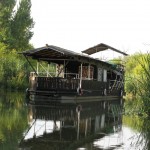The unique Zasavica nature reserve is located at the westernmost point of Serbia, east of the Drina and south of the Sava. Untouched nature, authentic folklore and cultural and historic monuments make Zasavica an important tourist destination. The boat takes visitors through the most beautiful parts of the reserve – the ride is seven kilometres long and offers a ... Read More »
Category Archives: On the city rims
Feed SubscriptionSmederevo
Smederevo is located some fifty kilometres east of Belgrade, on the right bank of the Danube. Smederevo has developed into an industrial town over the last several decades, although its environment abounds with cultural and historic monuments and tourist attractions. Its main attraction is the Smederevo Fortress, built during the first half of the 15th century as a new ... Read More »
Oplenac
Oplenac, the unofficial capital of the Karageorgevich dynasty, is located on a hill above Topola, eighty kilometres south of Belgrade. Oplenac features the magnificent mausoleum of the Karageorgevich royal family, which may be seen from great distances and represents a specific road-sign towards Topola. The Church of St. George was during the early 20th century and is one of ... Read More »
Sremski Karlovci
Sremski Karlovci stood as the cultural, political and religious centre of the Serbian people in the Austro-Hungarian Empire for two full centuries. The Palace of the Patriarchy with iconostases containing paintings by Uroš Predić, the First Serbian Gimnasium, the Orthodox Cathedral containing several paintings by Paja Jovanović, the Four Lions baroque fountain and many other important monuments date from ... Read More »
Carska Bara
Carska Bara used to be the favourite hunting ground of prince Rudolf and arch-duke Franz Ferdinand, who were not destined to become Austrian emperors, though they gave Carska bara its name (“Royal Pond”). Today this is a nature reserve with a permanent hunting ban. The reserve extends over almost 1,700 hectares and includes Carska Bara, Perleska Bara and Tiganjica, ... Read More »
Viminacium
The Roman military camp and the capital of the Roman province of Upper Moesia has been the subject of archaeological research over the past four decades. The destruction of Viminacium under the advance of the Huns may be compared to the famous destruction of Pompeii and Herculaneum under the eruption of Vesuvius. Accommodating some fifty thousand inhabitants, Viminacium was ... Read More »
Aranđelovac
Aranđelovac is located 75 km south of Belgrade, in the heart of Šumadija. It is encircled by two mountains and its numerous thermal springs with healing properties attract a large number of tourists each year. The main street of Aranđelovac is the right place to take an evening stroll. This promenade abounds with small shops, old artisan shops and ... Read More »
Vinca
Vinca is a small suburb settlement, 14 km away from the city center, next to which is the famous archaeological site from the period of 4500-3200 BC. Here are the remains of the largest prehistoric settlements in Serbia and one of the most important sites from the Neolithic period in Europe. This tour takes you by bus to the ... Read More »
Mountain Avala
Avala is one of the closest resort of Belgradians. It is situated about 15 km south of Belgrade and is 511 meters high. It represents a protected natural area of 489 hectares. On the mountain is the recently rebuilt Avala Tower, as well as monument of the Unknown Soldier created by the famous sculptor Ivan Mestrovic and the Monument ... Read More »
Fruška gora
The Fruška Gora national park is located in the north-west of Belgrade, along the right bank of the Danube. As many as 35 temples were built herein between the 15th and 18th century, with 15 orthodox monasteries surviving to this day. Due to their cultural and historic significance, the monasteries were put under UNESCO protection, and the mountain is ... Read More »
 CBelgrade See Belgrade, City Guide, Belgrad, Serbia
CBelgrade See Belgrade, City Guide, Belgrad, Serbia


